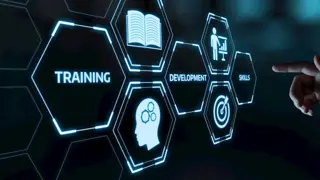
IT : IT Training Beginner to Intermediate
Free eCertificate | Unlimited time | Tutor Support | Video Lessons
Frontier Education
Summary
- Reed courses certificate of completion - Free
- Tutor is available to students
Add to basket or enquire
Overview
This IT training course enables you to delve deeply into IT, to better explore, understand and apply relevant skills.
Through this IT Training course, you will gain a world-class knowledge and understanding with a focus on IT Training, based on solving real-life issues.
This IT Training course includes a whole host of practical tips and advice, helping you to develop your IT Training skills to become the IT professional, manager, training and development officer, or related profession you can be.
This IT training course is intended for anyone with an interest in IT Training and it does not require any previous expertise or knowledge of IT Training . We will explore the key ideas, models, and findings of the main IT theories.
Whether you’re a newcomer in IT or already have an established role within your company, this IT Training course can provide you with the digital IT education you need to help your IT career or organisation thrive.
Whether you’ve been tinkering with IT for your business already or are completely new to the field of IT Training, you’ve come to the right place. This IT Training course, developed by experts, includes an industry-relevant curriculum designed to prepare you for a role in IT.
This IT Training course was designed to give you the tools and strategies you need to create a measurable impact in your career — whether your impact goal is to get a job, to enhance skills, or to make a positive difference in some other way.
This is four courses bundle and they are:
Course 1: Learn Ethical Hacking From A-Z - Beginner To Expert Course
Course 2: Microsoft Excel
Course 3: Microsoft Access
Course 4: Computer Networks Security from Scratch to Advanced
Packed with videos, PDFs and exercises, it'll equip you with what it takes to be successful in today’s business landscape, covering a broad range of topics, including the current cybersecurity market, the 3 types of hackers, common methods of hacking, common methods of hacking and much more.
Frontier Education provides those with no previous experience or working professionals with trailblazing, practice-based teaching, aimed to inspire and prepare you for a career in IT.
Benefits of taking IT course with Frontier Education:
- Learner support via live chat after starting IT Training course
- Dedicated tutor support from Monday to Friday with your IT Training course
- After completion of IT Training course you will receive Free certificate of completion
- You can access this IT training course on your mobile, desktop or laptop from anywhere with internet access.
Curriculum
-
Course Intro 54:40
-
Networking Basics 32:46
-
Setting up Your Hacking Lab 44:49
-
Linux+Python+Bash+Powershell Basics 47:30
-
How to Remain Anonymous 21:52
-
How to Hack Wifi 38:27
-
PAssive Active_Reconnaisseve 1:02:41
-
Launching Attacks 1:43:25
-
Post Exploitation 1:08:36
-
Website_Web Application Hacking 1:40:19
-
Mobile Phone Hacking Security 18:50
-
Getting your name out there as a Hacker 1:00:35
-
How to make money as an etichal hacker 26:05
-
How to start a career in cybersecurity 16:14
-
Resources 06:00
-
Intro 09:57
-
Section 1 51:22
-
Section 2 51:11
-
Section 3 58:18
-
Section 4 48:13
-
Section 5 52:23
-
Section 6 46:38
-
Section 7 42:04
-
Section 8 45:42
-
Section 9 48:25
-
Section 10 31:02
Course media
Description
In this IT Training course, you will learn and understand the core theories and practices in IT Training, developing a solid base of knowledge.You will understand core IT Training theories and practices and be able to think critically, actively contributing towards the body of knowledge in the industry and pushing the boundaries with IT Training skills.
With expert guidance and a combination of videos, PDFs, and worksheets, this course is designed to prepare you for a career or learning journey.
Course curriculum:
Course 1: Learn Ethical Hacking From A-Z - Beginner To Expert Course
Course 2: Microsoft Excel
Course 3: Microsoft Access
Course 4: Computer Networks Security from Scratch to Advanced
Section One: Introduction to Computer Networks
- Lecture 1: IT:What is a Computer Network?
- Lecture 2: IT:Computer Networks Topologies
- Lecture 3: IT:Computer Networks Categories
- Lecture 4: IT:Computer Networks Devices and Services
- Lecture 5: IT:Computer Networks Transmission Media
Section Two: ISO/OSI Model (7 Layers)
- Lecture 1: IT:Why ISO/OSI Model?
- Lecture 2: IT:Application, Presentation, and Session Layers
- Lecture 3: IT:Transport and Network Layers
- Lecture 4: IT:Data Link and Physical Layers
- Lecture 5: IT:ISO/OSI Model in Action
Section Three: TCP/IP Protocol Suite
- Lecture 1: IT:Introduction to Computer Networks Protocols
- Lecture 2: IT:IP Protocol
- Lecture 3: IT:TCP and UDP Protocols
- Lecture 4: IT:Application Protocols
- Lecture 5: IT:TCP/IP Characteristics and Tools
Section Four: Wireless Networks
- Lecture 1: IT:Wireless Networks Benefits
- Lecture 2: IT:Wireless Networks Types
- Lecture 3: IT:Wireless Networks Protocol (Wi-Fi)
- Lecture 4: IT:Wireless Networks Devices
- Lecture 5: IT:Wireless Networks Drawbacks
Section Five: Computer Networks Security
- Lecture 1: IT:Security Goals
- Lecture 2: IT:Securing the Network Design
- Lecture 3: IT:TCP/IP Security and Tools
- Lecture 4: IT:Port Scanning and Tools
- Lecture 5: IT:Sniffing and Tools
Section Six: Firewalls and Honeypots
- Lecture 1: IT:Why Using a Firewall?
- Lecture 2: IT:Firewalls Rules
- Lecture 3: IT:Firewalls Filtering
- Lecture 4: IT:Honey Pots
- Lecture 5: IT:Bypassing Firewalls
Section Seven: Intrusion Detection and Prevention systems (IDS/IPS)
- Lecture 1: IT:What is Intrusion Detection Systems (IDS)?
- Lecture 2: IT:Network IDS (NIDS)
- Lecture 3: IT:NIDS Challenges
- Lecture 4: IT:Snort as NIDS
- Lecture 5: IT:Intrusion Prevention Systems (IPS)
Section Eight: Wireless Networks Security
- Lecture 1: IT:Wired Equivalent Privacy WEP Attacking
- Lecture 2: IT:WPA and AES Protocols
- Lecture 3: IT:Wireless Security Misconceptions
- Lecture 4: IT:Wireless Attacks and Mitigation
- Lecture 5: IT:Secure Network Design with Wireless
Section Nine: Physical Security & Incident Handling
- Lecture 1: IT:Physical Security Objectives
- Lecture 2: IT:Physical Threats and Mitigation
- Lecture 3: IT:Defence in Depth (DiD)
- Lecture 4: IT:What is an Incident?
- Lecture 5: IT:Incident Handling
Section Ten: Computer Networks Security Conclusion
- Lecture 1: IT:Confidentiality, Integrity, and Availability (CIA)
- Lecture 2: IT:Assets, Threats, and Vulnerabilities
- Lecture 3: IT:Risks and Network Intrusion
- Lecture 4: IT:Common Attacks
- Lecture 5: IT:Security Recommendations
You’ll also be able to access a number of exclusive bonus resources to help you along your IT Training journey, including:
- Setting up your hacking lab
- Linux+python+bash+power shell basics
- How to hack wifi
- Mobile phone hacking security
- How to make money as an ethical hacker
Top reasons to Study Online at Frontier Education
- Tailor-made: Course adapted to market needs and interests
- Flexible programs: study and work at your own pace on easy-to-use web platforms
- Online education: progressive teaching methods with video or easy to understanding the medium
- Multicultural: connect with classmates from all corners of the globe
Who is this course for?
IT Training enables to undertake new and different tasks - this can lead to job enhancements, promotion and increased motivation and job satisfaction. helps to gain confidence in their use of IT - this can increase their productivity and efficiency.
This IT Training for anyone looking to develop their skills and knowledge in IT, as well as people wants to progress their career into a IT professional
- Anyone wants to enhance IT (ICT) skills and knowledge,
- Anyone wants to use IT (ICT) in his career or profession,
- Anyone need IT (ICT) skills for new job application and opportunities,
- Wants to learn IT (ICT) and apply in real life,
- Wants to demonstrate IT (ICT) to prospective employer or job,
- Anyone wants apply IT (ICT) skills and dive into relevant career path
It course also is for those wants to
- Improved organisational agility using IT (ICT) .
- Better and faster decision making with knowledge of IT (ICT).
- Quicker problem-solving using IT (ICT).
Requirements
There are no prerequisites to start this IT course but it would be beneficial for candidates to have internet in IT and basic knowledge of the English.Candidates with no prior IT knowledge or skills can start this IT course and get ready for IT tasks and responsibilities.
Career path
This IT course helps you to demonstrate IT skills and knowledge to prospective employer or apply in real life.
Prospective IT careers paths include but not limited to
- IT Customer Support
- IT Manager
- IT Support Manager
- IT Support Associate
- IT Support Technician
- IT Support Specialist
- IT Technical Support Engineer
- IT Technician
Questions and answers
Currently there are no Q&As for this course. Be the first to ask a question.
Certificates
Reed courses certificate of completion
Digital certificate - Included
Will be downloadable when all lectures have been completed
Reviews
Currently there are no reviews for this course. Be the first to leave a review.
Legal information
This course is advertised on reed.co.uk by the Course Provider, whose terms and conditions apply. Purchases are made directly from the Course Provider, and as such, content and materials are supplied by the Course Provider directly. Reed is acting as agent and not reseller in relation to this course. Reed's only responsibility is to facilitate your payment for the course. It is your responsibility to review and agree to the Course Provider's terms and conditions and satisfy yourself as to the suitability of the course you intend to purchase. Reed will not have any responsibility for the content of the course and/or associated materials.


